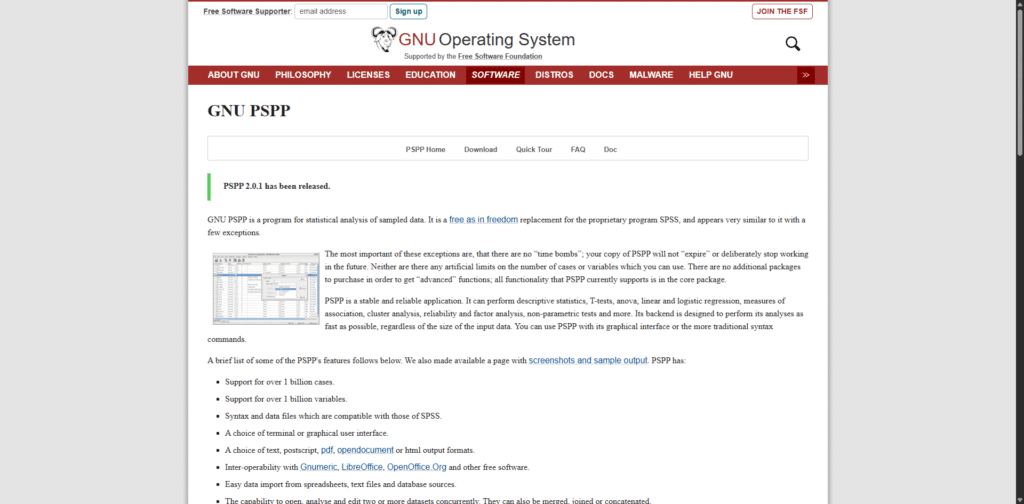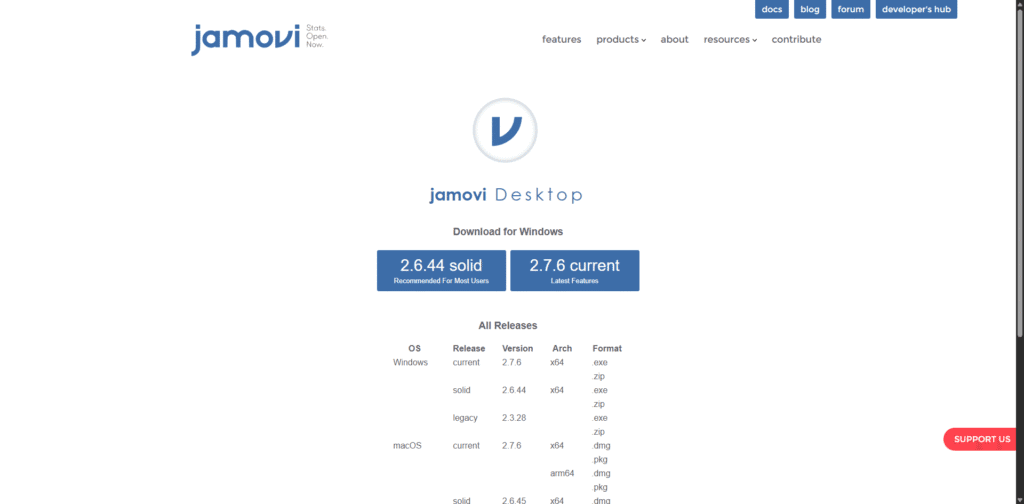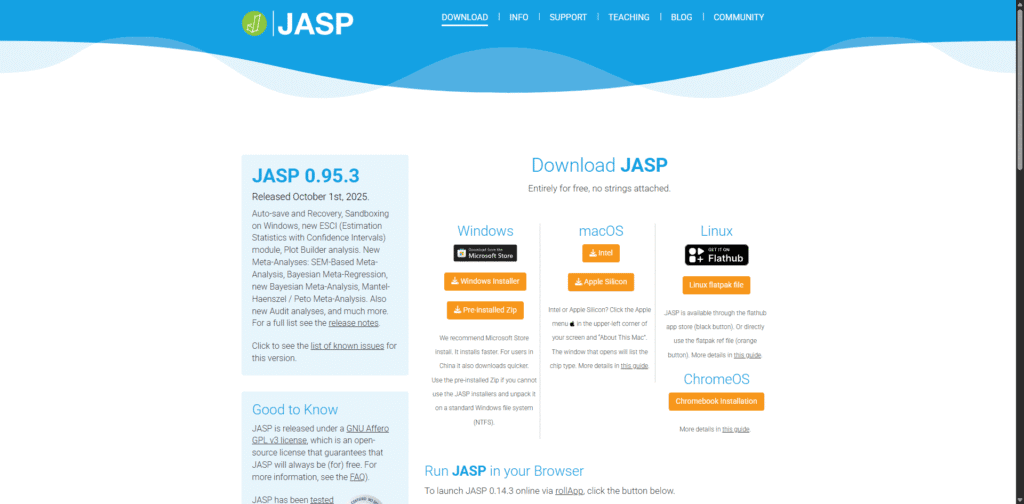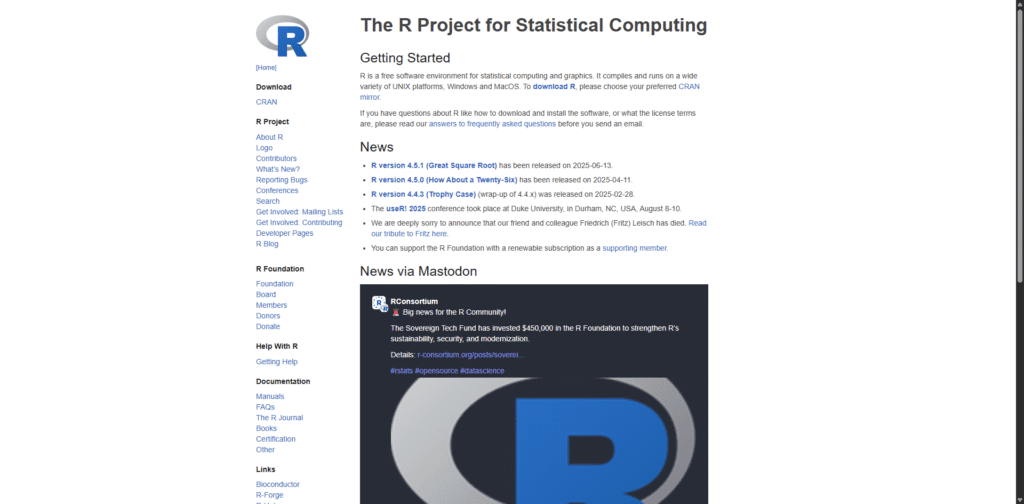Are you looking for a free SPSS alternative? Let’s be honest—SPSS licences can cost over $100 a month, and before you know it, you’re spending hundreds or even thousands a year just to run your analyses. If you’re a student, researcher, or small team trying to stretch your resources, paying that much doesn’t always make sense.
The good news? You don’t have to compromise on power or features. There are several free tools out there that can handle the same statistical tests, graphs, and models SPSS does. In this post, I’m going to walk you through the best options, share real examples of people who made the switch successfully, and give you practical steps to get started. By the end, you’ll see how easy it can be to save money without losing any analytical muscle.
Why Switch from SPSS?
SPSS costs accumulate fast. A 2023 survey by the American Statistical Association found that 62% of users spend over $500 a year on software licences. Free alternatives, on the other hand, allow you to perform complex statistical analyses without spending a penny.
Cost Savings Breakdown
- SPSS perpetual licence: $2,500+ for the basic version.
- Free tools: No upfront fees, plus regular updates through open-source communities.
Example: A university department switched to R and saved over $10,000 in software costs alone, freeing funds for training and research resources.
Common Pain Points with SPSS
- Steep learning curve for non-experts.
- Limited free trials that push users into early purchases.
“SPSS locks you in; open tools free your workflow,” says Dr Jane Lee, statistics professor.
Benefits of Free Switches
- Access to vibrant, supportive online communities.
- Scalable options for large datasets.
Actionable tip: Audit your current SPSS workflows and map each task to its free alternative counterpart.
PSPP: The Best Free SPSS Alternative
If you’re looking for a powerful statistical analysis tool without the hefty price tag of IBM SPSS, PSPP is an excellent choice. PSPP is a free, open-source software designed to perform statistical analysis on sampled data, offering many features familiar to SPSS users. Developed by the GNU Project, PSPP aims to provide a robust, accessible tool for students, researchers, and data analysts.
What is PSPP?
PSPP stands for “GNU PSPP” and is often described as a free replacement for SPSS. Its interface and functions are designed to be similar to SPSS, making it easier for those who have experience with commercial statistical software to transition. PSPP is cross-platform, meaning it works on Windows, macOS, and Linux, and it handles both small and large datasets efficiently.

Key Features
PSPP provides a wide array of statistical functions suitable for social sciences, business, and research applications:
- Descriptive Statistics: Compute means, standard deviations, frequencies, cross-tabulations, and more.
- T-Tests: Perform one-sample, independent, and paired sample t-tests.
- ANOVA: Conduct one-way and factorial analysis of variance.
- Regression Analysis: Linear and logistic regression to examine relationships between variables.
- Non-Parametric Tests: Includes chi-square, Mann-Whitney U, Wilcoxon, and Kruskal-Wallis tests.
- Data Management: Import and export data from various formats, recode variables, compute new variables, and manage datasets efficiently.
- Syntax and Scripting: Supports command-line syntax similar to SPSS, allowing reproducible analyses and automation.
- Graphs and Charts: Generate basic plots such as histograms, boxplots, and scatterplots to visualise your data.
Why Choose PSPP?
- Free and Open-Source
Unlike SPSS, PSPP is completely free to download and use. There are no trial periods or subscription fees, making it ideal for students, educators, and researchers on a budget. - Familiar Interface
PSPP’s layout resembles SPSS, including menus, dialog boxes, and syntax options. Users familiar with SPSS can easily adapt to PSPP without a steep learning curve. - Cross-Platform
Whether you use Windows, macOS, or Linux, PSPP is compatible, ensuring accessibility regardless of your operating system. - Lightweight and Fast
PSPP runs efficiently even on older hardware or computers with limited resources, making it accessible for all users. - Community Support
As an open-source project, PSPP has a supportive community and extensive documentation, tutorials, and forums to help new users get started.
Limitations to Consider
While PSPP is a strong alternative, there are some differences from SPSS:
- Advanced Features: Some advanced statistical procedures and modules available in SPSS (like Structural Equation Modelling or Advanced Bayesian Statistics) are not included.
- Graphing Capabilities: PSPP’s charting and visualization features are more basic compared with SPSS.
- User Interface Updates: The interface is functional but not as polished as commercial software.
Getting Started
- Download: Visit the official PSPP website: https://www.gnu.org/software/pspp/
- Install: Choose your platform (Windows, macOS, Linux) and follow the installation instructions.
- Import Data: PSPP supports importing
.sav(SPSS),.csv, and other common file formats. - Analyse: Use menus or syntax to run descriptive statistics, t-tests, ANOVA, regression, and more.
- Visualise: Create basic graphs to complement your analysis.
Jamovi: A User-Friendly, Free SPSS Alternative
If you’re seeking a powerful yet accessible statistical analysis tool without the hefty price tag of IBM SPSS, Jamovi is an excellent choice. Jamovi is a free, open-source software designed to perform statistical analysis on sampled data, offering many features familiar to SPSS users. Developed by the Jamovi Project, it aims to provide a robust, accessible tool for students, researchers, and data analysts.
What is Jamovi?
Jamovi is a free and open-source statistical analysis software built on top of the R programming language. It provides a user-friendly graphical user interface (GUI) that simplifies statistical analysis, making it accessible to users without programming experience. Jamovi is cross-platform, meaning it works on Windows, macOS, and Linux, and it handles both small and large datasets efficiently.

Key Features
Jamovi offers a comprehensive suite of statistical analyses suitable for social sciences, business, and research applications:
- Descriptive Statistics: Compute means, standard deviations, frequencies, cross-tabulations, and more.
- T-Tests: Perform one-sample, independent, and paired sample t-tests.
- ANOVA: Conduct one-way and factorial analysis of variance.
- Regression Analysis: Linear and logistic regression to examine relationships between variables.
- Non-Parametric Tests: Includes chi-square, Mann-Whitney U, Wilcoxon, and Kruskal-Wallis tests.
- Reliability Analysis: Assess the consistency of a set of measurements.
- Factor Analysis: Identify underlying relationships between variables.
- Data Management: Import and export data from various formats, recode variables, compute new variables, and manage datasets efficiently.
- Syntax and Scripting: Supports R scripting, allowing for advanced analyses and automation.
- Graphs and Charts: Generate high-quality plots such as histograms, boxplots, and scatterplots to visualise your data.
- Real-Time Analysis: Changes to the data are immediately reflected in the results, facilitating an interactive analysis experience.
Why Choose Jamovi?
- Free and Open-Source
Unlike SPSS, Jamovi is completely free to download and use. There are no trial periods or subscription fees, making it ideal for students, educators, and researchers on a budget. - User-Friendly Interface
Jamovi’s layout is intuitive and easy to navigate, featuring a spreadsheet-like data editor and a results pane. This design makes it accessible for those new to statistical analysis. - R Integration
Built on top of the R statistical language, Jamovi provides access to the extensive capabilities of R while maintaining a user-friendly interface. Users can also write and execute R scripts within Jamovi for advanced analyses. - Cross-Platform Compatibility
Whether you use Windows, macOS, or Linux, Jamovi is compatible, ensuring accessibility regardless of your operating system. - Community-Driven Development
As an open-source project, Jamovi benefits from contributions by a global community of users and developers, who continually work on improving the software and adding new functionalities. - Extensibility
Jamovi supports modules that can be installed to extend its functionality. These modules cover a wide range of analyses, including structural equation modeling, meta-analysis, and more.
Limitations to Consider
While Jamovi is a robust alternative, there are some differences from SPSS:
- Advanced Features: Some advanced statistical procedures and modules available in SPSS may not be included in Jamovi.
- Graphing Capabilities: While Jamovi offers a variety of plots, users requiring highly customized visualizations may find its capabilities limited compared to other software.
- Learning Curve for R Integration: While the GUI is user-friendly, utilizing R scripting within Jamovi may require some familiarity with R programming.
Getting Started
- Download: Visit the official Jamovi website: https://www.jamovi.org/download.html
- Install: Choose your platform (Windows, macOS, Linux) and follow the installation instructions.
- Import Data: Jamovi supports importing
.csv,.xlsx,.sav(SPSS), and other common file formats. - Analyse: Use the intuitive menus to run descriptive statistics, t-tests, ANOVA, regression, and more.
- Visualise: Create high-quality graphs to complement your analysis.
- Extend: Explore and install additional modules from the Jamovi library to expand your analytical capabilities.
JASP: Open-Source Alternative to SPSS
If you’re seeking a powerful yet accessible statistical analysis tool without the hefty price tag of IBM SPSS, JASP is an excellent choice. JASP is a free, open-source software designed to perform statistical analysis on sampled data, offering many features familiar to SPSS users. Developed by the University of Amsterdam, JASP aims to provide a robust, accessible tool for students, researchers, and data analysts.
What is JASP?
JASP stands for Jeffreys’s Amazing Statistics Program. It is a free and open-source statistical analysis software built on top of the R programming language. JASP provides a user-friendly graphical user interface (GUI) that simplifies statistical analysis, making it accessible to users without programming experience. JASP is cross-platform, meaning it works on Windows, macOS, and Linux, and it handles both small and large datasets efficiently.

Key Features
JASP offers a comprehensive suite of statistical analyses suitable for social sciences, business, and research applications:
- Descriptive Statistics: Compute means, standard deviations, frequencies, cross-tabulations, and more.
- T-Tests: Perform one-sample, independent, and paired sample t-tests.
- ANOVA: Conduct one-way and factorial analysis of variance.
- Regression Analysis: Linear and logistic regression to examine relationships between variables.
- Non-Parametric Tests: Includes chi-square, Mann-Whitney U, Wilcoxon, and Kruskal-Wallis tests.
- Reliability Analysis: Assess the consistency of a set of measurements.
- Factor Analysis: Identify underlying relationships between variables.
- Meta-Analysis: Combine results from multiple studies to identify patterns and draw conclusions.
- Data Management: Import and export data from various formats, recode variables, compute new variables, and manage datasets efficiently.
- Syntax and Scripting: Supports R scripting, allowing for advanced analyses and automation.
- Graphs and Charts: Generate high-quality plots such as histograms, boxplots, and scatterplots to visualise your data.
- Real-Time Analysis: Changes to the data are immediately reflected in the results, facilitating an interactive analysis experience.
Why Choose JASP?
- Free and Open-Source
Unlike SPSS, JASP is completely free to download and use. There are no trial periods or subscription fees, making it ideal for students, educators, and researchers on a budget. - User-Friendly Interface
JASP’s layout is intuitive and easy to navigate, featuring a spreadsheet-like data editor and a results pane. This design makes it accessible for those new to statistical analysis. - R Integration
Built on top of the R statistical language, JASP provides access to the extensive capabilities of R while maintaining a user-friendly interface. Users can also write and execute R scripts within JASP for advanced analyses. - Cross-Platform Compatibility
Whether you use Windows, macOS, or Linux, JASP is compatible, ensuring accessibility regardless of your operating system. - Community-Driven Development
As an open-source project, JASP benefits from contributions by a global community of users and developers, who continually work on improving the software and adding new functionalities. - Extensibility
JASP supports modules that can be installed to extend its functionality. These modules cover a wide range of analyses, including structural equation modeling, meta-analysis, and more.
Limitations to Consider
While JASP is a robust alternative, there are some differences from SPSS:
- Advanced Features: Some advanced statistical procedures and modules available in SPSS may not be included in JASP.
- Graphing Capabilities: While JASP offers a variety of plots, users requiring highly customized visualizations may find its capabilities limited compared to other software.
- Learning Curve for R Integration: While the GUI is user-friendly, utilizing R scripting within JASP may require some familiarity with R programming.
Getting Started
- Download: Visit the official JASP website: https://jasp-stats.org/download/
- Install: Choose your platform (Windows, macOS, Linux) and follow the installation instructions.
- Import Data: JASP supports importing
.csv,.xlsx,.sav(SPSS), and other common file formats. - Analyse: Use the intuitive menus to run descriptive statistics, t-tests, ANOVA, regression, and more.
- Visualise: Create high-quality graphs to complement your analysis.
- Extend: Explore and install additional modules from the JASP library to expand your analytical capabilities.
R: Open-Source SPSS Equivalent Software
If you are looking for a completely free and highly flexible tool for data analysis, R is one of the best options available. Unlike commercial software like SPSS, R is an open-source programming language and software environment specifically designed for statistical computing and graphics. It is widely used by statisticians, data scientists, researchers, and academics worldwide.
What is R?
R is a programming language and environment for statistical computing and graphics. Originally developed in the early 1990s, it has grown into one of the most popular tools for data analysis and visualization. Unlike GUI-based software like SPSS or Jamovi, R requires coding, but this provides unmatched flexibility and the ability to perform virtually any type of statistical analysis or data manipulation.
R is cross-platform, working on Windows, macOS, and Linux, and it supports a wide range of statistical and graphical techniques.

Key Features
R offers a comprehensive array of capabilities for statistical analysis and data visualisation:
- Descriptive Statistics: Compute means, standard deviations, medians, frequencies, cross-tabulations, and more.
- Inferential Statistics: Perform t-tests, ANOVA, chi-square tests, and non-parametric tests.
- Regression Analysis: Linear, logistic, and nonlinear regression, along with advanced models like mixed-effects models.
- Time Series Analysis: Tools for forecasting, smoothing, and analysing temporal data.
- Multivariate Analysis: Factor analysis, cluster analysis, principal component analysis, and more.
- Machine Learning: Includes packages for classification, regression, and clustering algorithms.
- Graphics and Visualization: Create publication-quality plots including histograms, scatterplots, boxplots, heatmaps, and interactive visualisations.
- Reproducibility: Analyses are fully reproducible through scripting.
- Extensibility: Thousands of packages available through CRAN (Comprehensive R Archive Network) for specific statistical methods, bioinformatics, econometrics, and more.
Why Choose R?
- Completely Free and Open-Source
R is entirely free to use for individuals, academic institutions, and businesses, with no licensing fees. - Highly Flexible
Unlike GUI-based software, R allows you to customise analyses, create advanced statistical models, and automate workflows using scripts. - Extensive Community and Support
R has a large, active global community. Thousands of packages and online resources are available to extend functionality and provide support. - Integration with Other Software
R integrates with databases, spreadsheets, and other software (e.g., Python, SQL, Excel) to handle diverse data sources. - Advanced Graphics and Reporting
Packages like ggplot2, plotly, and shiny allow you to create interactive visualisations and dashboards.
Limitations to Consider
While R is incredibly powerful, there are some challenges for beginners:
- Learning Curve: R requires learning a programming language, which may be intimidating for users accustomed to GUI-based software like SPSS.
- Memory Management: Very large datasets may require careful memory management or the use of additional packages.
- No Native GUI: While GUIs like RStudio make R easier to use, the core software is code-based.
Getting Started
- Download R: Visit https://www.r-project.org/ to download R for your operating system.
- Install RStudio (Recommended): RStudio is a free IDE (Integrated Development Environment) that makes using R much more user-friendly.
- Learn Basic Commands: Start with basic functions for descriptive statistics, plotting, and data manipulation.
- Install Packages: Use CRAN to install packages for advanced statistical analyses and visualisations.
- Analyse Data: Write scripts to import, clean, analyse, and visualise your data.
Conclusion
Free alternatives like PSPP, R, Jasp, and Jamovi offer SPSS-level power at no cost. With widespread adoption and proven savings, now is the perfect time to make the switch. Pick one tool, follow the steps, and transform how you work with data. For further guidance, explore the resources and communities mentioned throughout this post.
While you’re exploring free alternatives to SPSS, you might also want to check out my guide on Free AI Tools for Research Writing—they can save you hours on drafting, editing, and formatting your papers, making your research workflow even smarter.

